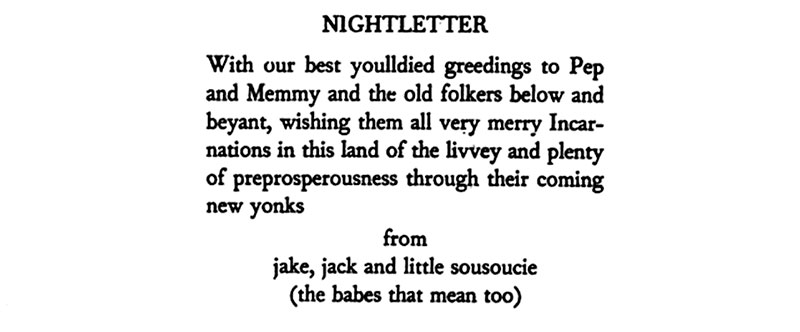He wanted people to read novels as carefully, as ardently and as sleeplessly as they would read dirty letters sent from abroad. It was one of modernism’s great insights. James Joyce treated readers as if they were lovers. From Kevin Birmingham’s new historical account of the publication of Ulysses, The Most Dangerous Book, which was reviewed very favorably in today’s NY Times.
Tag: james joyce
-
He Wanted People to Read Novels As Carefully As
-
Finnegans Wake New Yonks

Happy new yonks, everyone!
(From Finnegans Wake, p. 308)
-
John Cage on the Beauty of the Moon
I don’t agree. I think that we can still at unexpected moments be surprised by the beauty of the moon though now we can travel to it. John Cage, in response to critics claiming an urgency for the scholarly, analytical study of “difficult to understand” twentieth Century art, quoted from this acceptance speech in which he talks about Finnegans Wake and his own works influenced by that book.
-
Google Joyce
Yeah. Hello, This is a message from Super Shuttle scheduled to pick you up. Yeah 6 Yes team. In the morning. Yeah going to Byron bird from the airport. Yeah if you need to make any changes. Yes. Call 5 Yeah, 12, your moving on. Yeah, we will see you tomorrow. Sunday. Yeah 6 yeah. 15. Yeah in the morning. Yeah. Please allow up to you Yeah, 15 minutes. Yeah, after scheduled pickup time, for traffic, your routing yo of other passengers yank you for choosing Super Shuttle, yeah. And please, buckle up force safety. Yeah. Google Voice’s transcription of an automated robo-call I just got from Super Shuttle, which seems to be channeling Molly Bloom’s soliloquy. I’ve joked about Google Freud before, so I’ll chalk this one up as Google Joyce.
-
James Joyce Synthetic Cell
To live, to err, to fall, to triumph, to recreate life out of life.
The above quote from James Joyce’s Portrait of the Artist as a Young Man was inscribed as a watermark into the DNA of the much-discussed synthetic cell created a couple of months back by Craig Venter’s team. From The Loom:
The scientists who produced the new synthetic cell copied the genome of a microbe, letter for letter, and then inserted the synthetic version into a host cell. To determine that their experiment worked, they needed a way to tell the genomes of their synthetic cells from the natural genomes that were their model. So they inserted “watermarks” into the artificial genome. These sequences of DNA (which spelled out the work of Joyce and others through the genetic code) sit in non-coding regions of the microbe’s DNA. As a result, these watermarks cannot disrupt any essential protein-coding genes or stretches of DNA that are vital for switching genes on and off.
